Visualization techniques can significantly enhance healing and personal empowerment by promoting mental clarity and emotional resilience. This article explores various methods such as guided imagery, mindfulness meditation, and affirmations. It also examines cultural influences on visualization practices, addresses common challenges, and highlights emerging techniques like virtual reality and art therapy. Finally, it provides strategies for integrating visualization into daily life to foster personal growth and well-being.
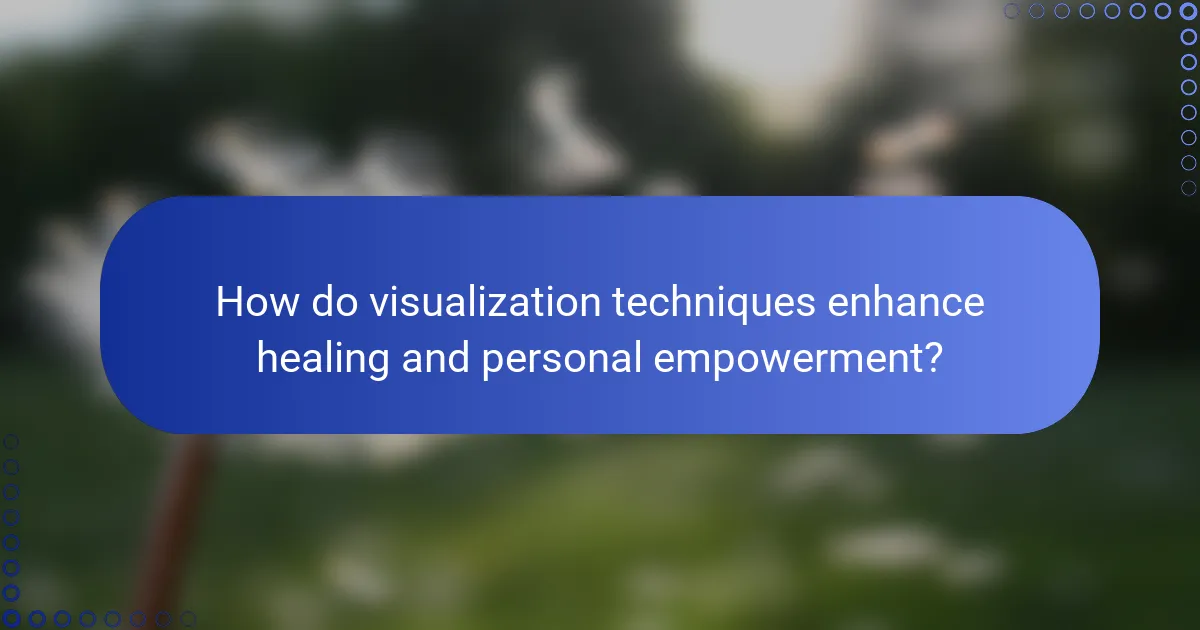
How do visualization techniques enhance healing and personal empowerment?
Visualization techniques significantly enhance healing and personal empowerment by fostering mental clarity and emotional resilience. These techniques enable individuals to visualize positive outcomes, which can lead to reduced stress and improved overall well-being.
Research shows that visualization can activate the brain’s neural pathways, similar to physical practice. This mental rehearsal can enhance performance in various areas, including health recovery and personal growth.
Additionally, visualization techniques often incorporate unique attributes, such as guided imagery and affirmation practices, which can further personalize the experience. These methods allow individuals to connect deeply with their goals and aspirations, reinforcing a sense of agency and control over their healing journey.
As a result, adopting visualization techniques can empower individuals to overcome challenges, improve their mental health, and achieve their desired outcomes effectively.
What are the psychological benefits of visualization in healing?
Visualization techniques enhance healing by promoting mental clarity, reducing stress, and fostering emotional resilience. These psychological benefits empower individuals to envision positive outcomes, which can lead to improved physical health. Studies show that visualization can lower anxiety levels and increase overall well-being. This practice also encourages self-efficacy, enabling individuals to take proactive steps in their healing journeys.
How does visualization contribute to personal empowerment?
Visualization enhances personal empowerment by fostering self-awareness and clarity of goals. It allows individuals to create mental images that align with their aspirations, thus promoting motivation and focus. By regularly practicing visualization techniques, individuals can reduce anxiety and increase confidence, contributing to a stronger sense of agency in their lives. Techniques such as guided imagery and vision boards serve as effective tools for manifesting desired outcomes and reinforcing positive beliefs.
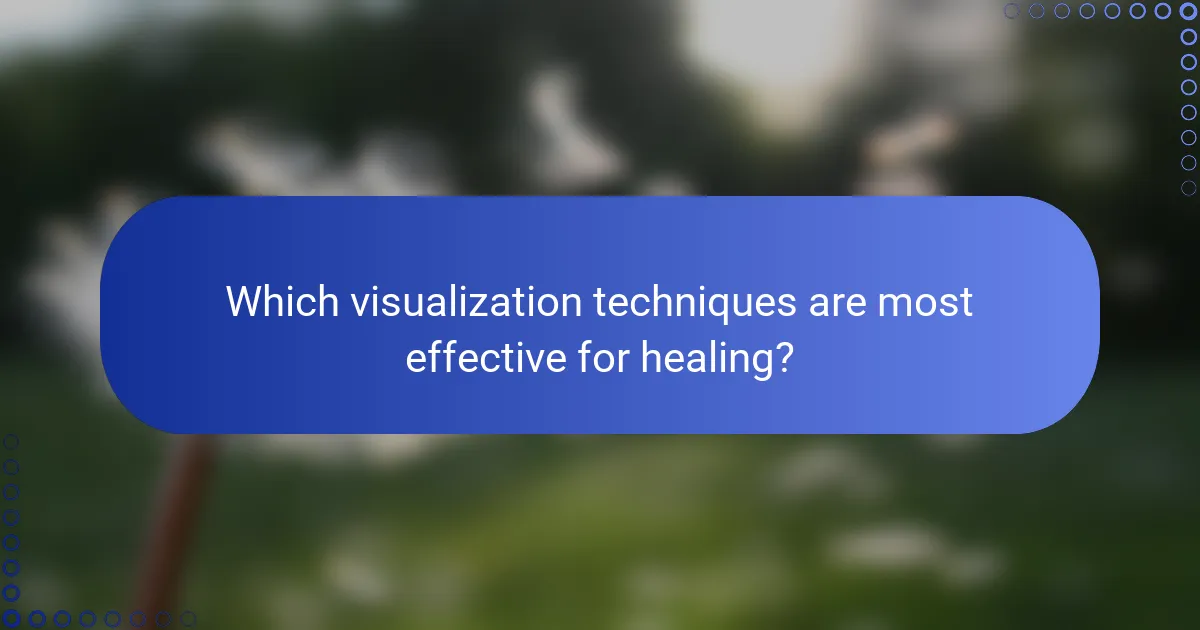
Which visualization techniques are most effective for healing?
Visualization techniques for healing include guided imagery, mindfulness meditation, and affirmations. These methods enhance mental clarity, reduce stress, and promote emotional well-being. Guided imagery allows individuals to visualize healing scenarios, fostering a sense of empowerment. Mindfulness meditation cultivates present-moment awareness, which can alleviate anxiety and enhance overall health. Affirmations reinforce positive beliefs, supporting personal growth and resilience. Each technique uniquely contributes to holistic healing by addressing emotional and psychological aspects.
What role does guided imagery play in therapeutic settings?
Guided imagery plays a significant role in therapeutic settings by facilitating relaxation and enhancing mental well-being. This technique allows individuals to visualize positive outcomes and experiences, promoting emotional healing and stress reduction. It can improve focus, self-awareness, and coping strategies, empowering clients in their personal growth. Research indicates that guided imagery can lead to decreased anxiety levels and improved overall health outcomes.
How can affirmations be integrated into visualization practices?
Affirmations can enhance visualization practices by reinforcing positive beliefs. Integrating affirmations involves using them as verbal cues during visualization sessions. For example, while visualizing a desired outcome, repeat affirmations related to that goal. This combination strengthens mental imagery and emotional connection. Consistent practice fosters a deeper belief in the visualization, increasing its effectiveness for healing and personal empowerment.
What are the benefits of using vision boards for personal growth?
Using vision boards enhances personal growth by clarifying goals, boosting motivation, and fostering positive thinking. They serve as visual reminders of aspirations, making goals more tangible and achievable. This technique taps into the power of visualization, which can lead to increased focus and a greater sense of purpose. Regular engagement with vision boards can cultivate a mindset conducive to success and well-being.
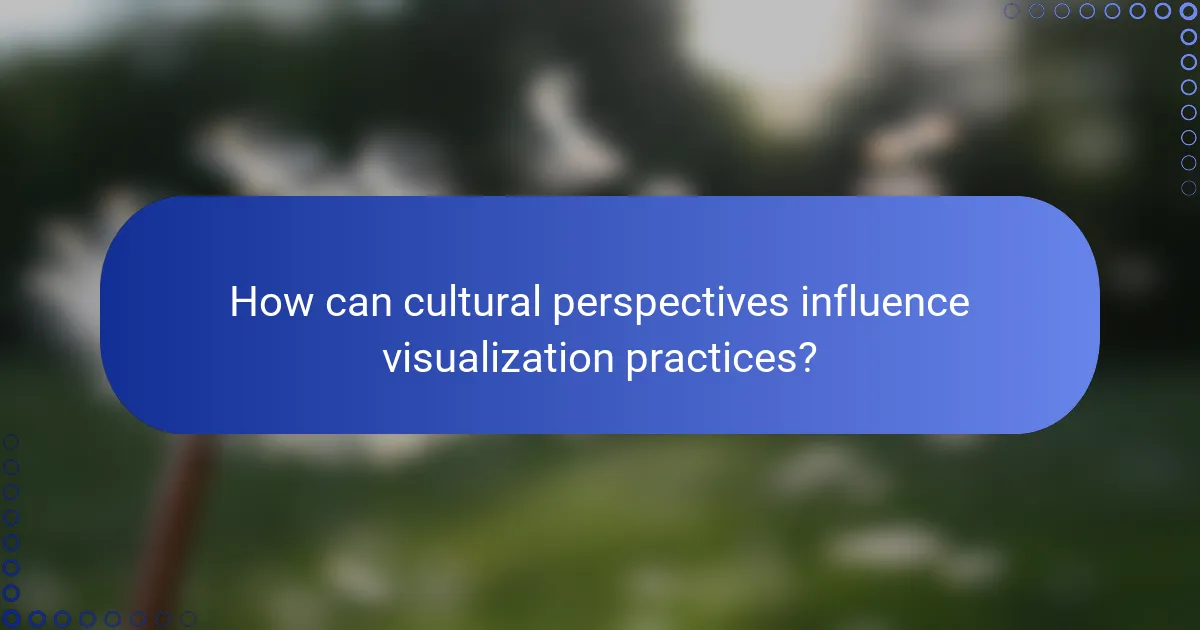
How can cultural perspectives influence visualization practices?
Cultural perspectives significantly shape visualization practices by influencing beliefs, values, and techniques. Different cultures emphasize unique symbols, colors, and narratives that affect how individuals visualize healing and personal empowerment. For instance, Eastern traditions often incorporate holistic approaches, while Western practices may focus on individualism and goal-setting. These cultural nuances can enhance the effectiveness of visualization by aligning techniques with the user’s cultural context, fostering deeper connections to the practice. Understanding these influences can lead to more tailored and impactful visualization strategies.
Which visualization techniques are popular in Eastern healing traditions?
Visualization techniques in Eastern healing traditions include guided imagery, chakra visualization, mandala drawing, and nature visualization. These methods promote mental clarity, emotional balance, and spiritual growth.
Guided imagery involves imagining peaceful scenes to reduce stress. Chakra visualization focuses on energy centers in the body to enhance healing. Mandala drawing serves as a meditative practice that fosters creativity and self-expression. Nature visualization connects individuals with the calming aspects of the natural world, promoting overall well-being.
How do Western approaches to visualization differ from Eastern methods?
Western approaches to visualization often emphasize analytical, structured methods, while Eastern methods focus on intuitive, holistic practices. Western techniques typically utilize data-driven visuals for clarity, whereas Eastern practices often incorporate symbolic imagery to foster emotional connection.
In Western contexts, visualization is often used in therapy and coaching to set specific goals and track progress. This contrasts with Eastern practices, which may employ visualization for meditation and spiritual growth, emphasizing the journey over measurable outcomes.
The unique attribute of Western visualization is its reliance on cognitive-behavioral principles, while Eastern methods are rooted in cultural traditions and philosophies, such as mindfulness and balance. This distinction highlights the rare attribute of integrating personal empowerment with a broader spiritual framework in Eastern practices.
Both approaches can complement each other, offering diverse tools for healing and personal empowerment. Integrating these techniques can enhance overall well-being by providing a balanced perspective on visualization.
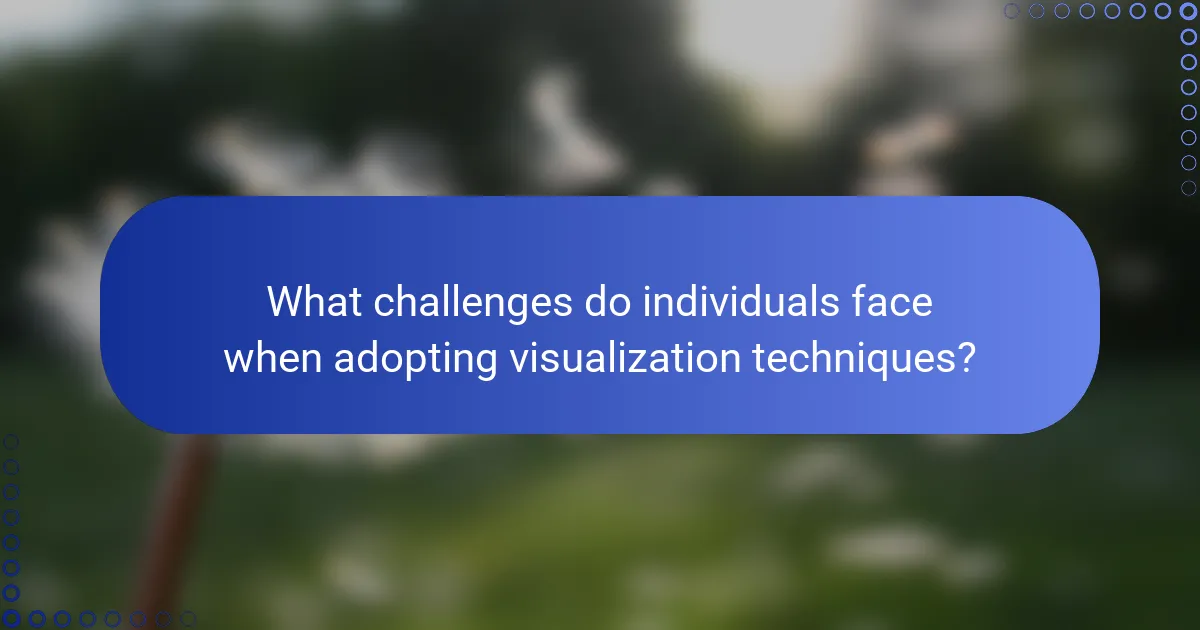
What challenges do individuals face when adopting visualization techniques?
Individuals face several challenges when adopting visualization techniques, including difficulty in maintaining focus, skepticism about effectiveness, and lack of guidance. Many struggle to visualize concepts clearly, which can hinder the intended healing and empowerment. Emotional barriers, such as fear of confronting inner thoughts, also pose significant obstacles. Additionally, time constraints may limit practice opportunities, reducing the benefits of visualization techniques.
How can skepticism be addressed in visualization practices?
Skepticism in visualization practices can be addressed through transparency, evidence-based methods, and community engagement. Providing clear explanations of techniques enhances trust. Sharing data supporting effectiveness fosters credibility. Involving participants in the visualization process encourages ownership and reduces doubt.
What common obstacles hinder effective visualization?
Common obstacles that hinder effective visualization include lack of clarity, emotional resistance, inadequate skills, and distractions. These factors can impede the process of using visualization techniques for healing and personal empowerment.
Lack of clarity arises when the individual is unsure about their goals or the desired outcome of the visualization. Emotional resistance can occur if past traumas or negative beliefs surface during the process. Inadequate skills may limit the effectiveness of visualization, particularly if techniques are not practiced regularly. Distractions, whether internal or external, can disrupt focus and diminish the impact of visualization exercises.
Addressing these obstacles is crucial for harnessing the full potential of visualization in personal growth and healing.
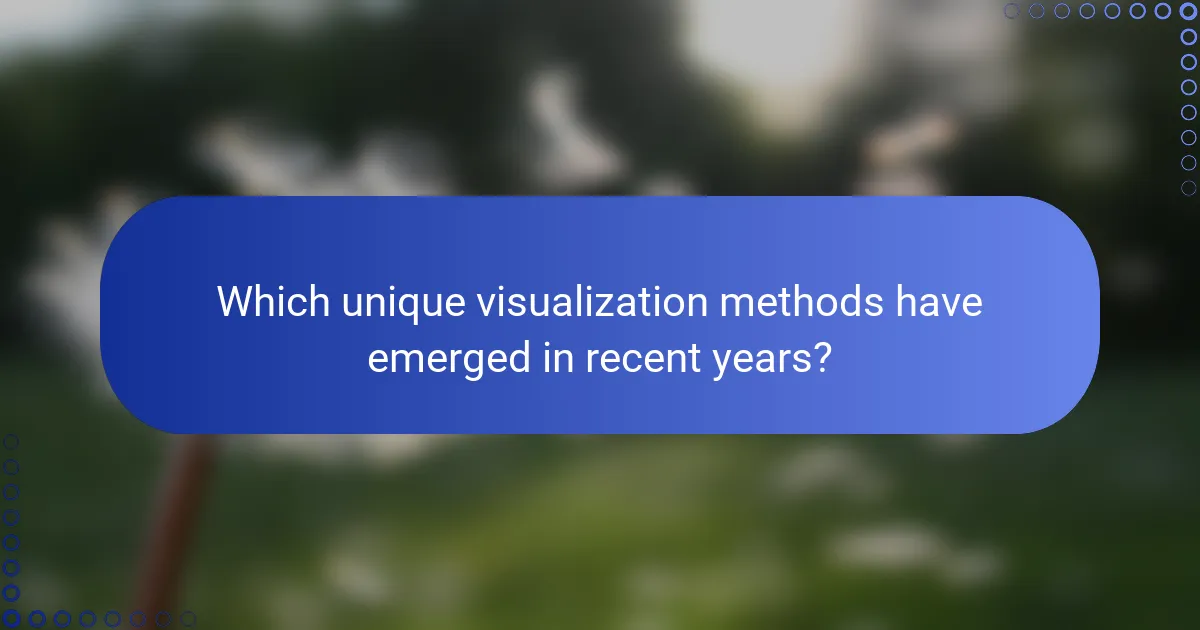
Which unique visualization methods have emerged in recent years?
Recent years have seen the emergence of unique visualization methods focused on healing and personal empowerment. Techniques such as immersive virtual reality experiences, interactive data storytelling, and art therapy visualization have gained traction.
Immersive virtual reality allows users to engage in therapeutic environments, promoting relaxation and self-discovery. Interactive data storytelling combines personal narratives with visual data, enhancing understanding of personal journeys. Art therapy visualization uses creative expression to facilitate emotional healing and empowerment.
These methods highlight the growing recognition of visualization as a tool for personal growth and well-being. Each technique offers distinct benefits that cater to individual healing processes.
How has technology shaped the evolution of visualization techniques?
Technology has significantly enhanced visualization techniques for healing and personal empowerment. Advanced tools like virtual reality and augmented reality create immersive experiences that facilitate emotional healing. Data visualization software allows individuals to track their progress and visualize personal growth, making abstract concepts more tangible. Furthermore, online platforms provide access to diverse visualization methods, empowering users to choose techniques that resonate with their unique healing journeys. These innovations foster deeper self-awareness and promote a proactive approach to personal development.
What innovative tools are available for enhancing visualization practices?
Innovative tools for enhancing visualization practices include software and applications designed for personal empowerment and healing. These tools often utilize interactive features, allowing users to create personalized visual experiences. Examples are virtual reality environments, guided imagery apps, and digital art platforms that facilitate self-expression and emotional processing. These technologies support users in visualizing goals, emotions, and healing journeys, fostering personal growth and empowerment.

How can individuals measure the effectiveness of their visualization efforts?
Individuals can measure the effectiveness of their visualization efforts by tracking specific outcomes and personal experiences. Key metrics include emotional shifts, clarity of goals, and overall well-being improvements. Regular self-assessment through journaling can provide insights into progress. Additionally, comparing before-and-after states can highlight tangible changes. Seeking feedback from trusted peers enhances perspective on the impact of visualization techniques.
What metrics can be used to assess personal growth through visualization?
Metrics to assess personal growth through visualization include self-reported emotional states, goal achievement rates, frequency of visualization practice, changes in stress levels, and improvements in self-efficacy. These metrics provide insights into the effectiveness of visualization techniques for healing and personal empowerment.
How can journaling complement visualization practices?
Journaling enhances visualization practices by providing clarity and reinforcing intentions. It allows individuals to articulate their goals and feelings, making visualizations more focused and effective. Writing down thoughts can deepen emotional connections, enhancing the overall healing process. Additionally, journaling serves as a reflective tool, enabling users to track progress and adjust their visualizations accordingly.
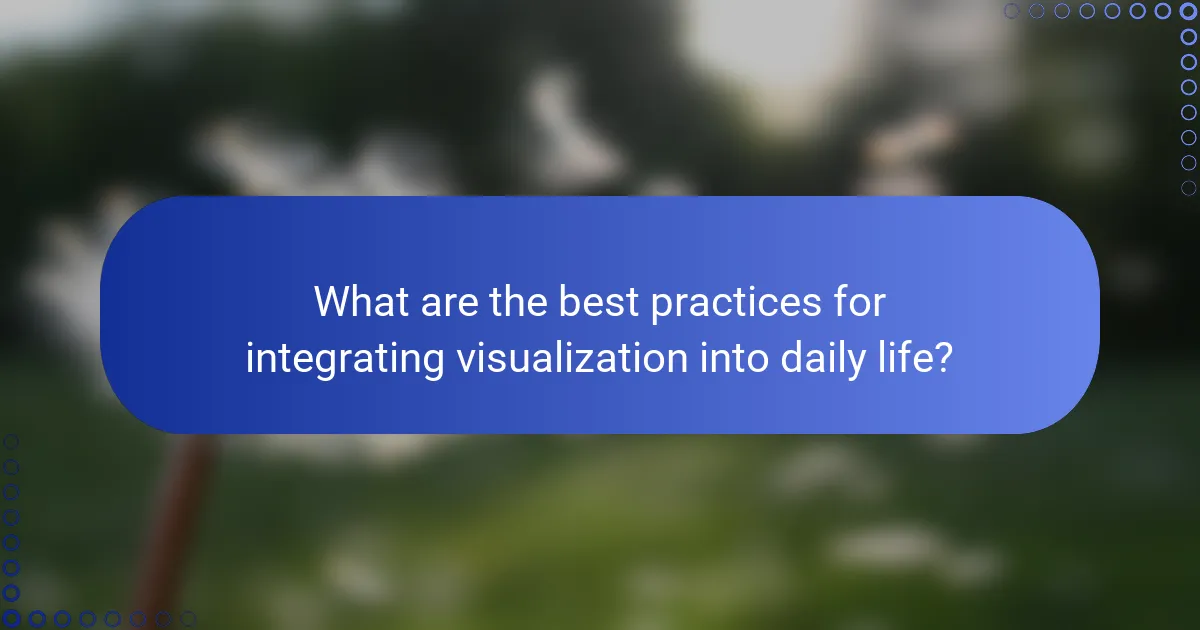
What are the best practices for integrating visualization into daily life?
Integrating visualization into daily life enhances healing and personal empowerment. Start by dedicating time each day for visualization practices that align with your goals.
1. Set clear intentions for your visualization sessions.
2. Create a calm environment free from distractions.
3. Use guided imagery or visualization apps for structure.
4. Incorporate visualization into daily routines, like meditation or exercise.
5. Reflect on your visualizations to reinforce positive outcomes.
These practices foster a deeper connection with your aspirations and promote mental well-being.
How can setting intentions improve visualization outcomes?
Setting intentions significantly enhances visualization outcomes by aligning focus and energy toward desired goals. Clear intentions create a mental framework that guides the visualization process, making it more effective. This practice fosters a sense of purpose, increasing motivation and engagement in healing and personal empowerment. As a result, individuals often experience deeper emotional connections to their visualizations, leading to improved outcomes.
What expert tips can enhance the effectiveness of visualization techniques?
To enhance the effectiveness of visualization techniques, focus on clarity, intention, and emotional connection. Start by defining clear goals for your visualization practice. Use vivid imagery and sensory details to create a strong mental picture. Incorporate positive affirmations to reinforce beliefs and feelings associated with the visualization. Regular practice and consistency will deepen the impact over time.
What common mistakes should be avoided when practicing visualization?
Common mistakes to avoid when practicing visualization include lack of clarity in goals, inconsistent practice, neglecting emotions, and overcomplicating imagery. Clear goals enhance focus and effectiveness. Regular practice strengthens visualization skills. Engaging emotions fosters deeper connections to the imagery. Keeping the process simple ensures accessibility and reduces frustration.